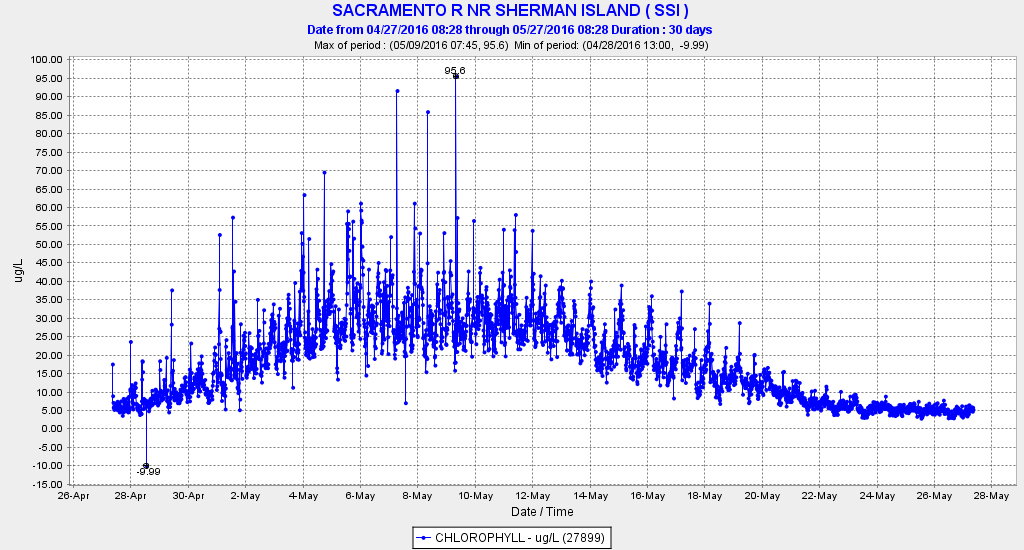In a May 17 post I discussed the occurrence of a rare spring Bay-Delta plankton bloom. The bloom coincided with moderate Delta inflow and outflow in the present “normal” water year combined with a pulse of Delta inflow from the San Joaquin River. The bloom and associated conditions likely benefitted smelt, salmon, striped bass, and other Bay-Delta fishes by providing cover (turbidity) and food for young fish.
The bloom has now dissipated in the Delta and Suisun Bay (Figures 1-3). In contrast, the bloom has continued to intensify in the San Joaquin River upstream of the Delta (Figures 4 and 5). The dissipation of the bloom coincided with the cessation of the San Joaquin pulse flow (2500-3500 cfs from April 18-May 15) combined with Delta inflow and outflow that is increasingly dominated by low turbidity, low nutrient water from the Sacramento River (Figure 6), mainly from high seasonal storage releases from Oroville (Feather River) and Folsom (American River) reservoirs. In addition, with total South Delta exports now between 2000-3000 cfs, most if not all of the remaining turbid, high nutrient San Joaquin bloom water is being exported before it reaches the central Delta.
This pattern of Delta hydrology in a “normal” Sacramento River water year and a “dry” San Joaquin River water year shows the importance of the nutrient-laden San Joaquin water in the overall productivity of the Bay-Delta estuary.

Figure 1. Chlorophyll concentration May 12-27, 2016 in the lower San Joaquin River channel of the Delta east of Antioch near Sherman Island. Concentrations above 10 micrograms per liter of water are considered indicative of high phytoplankton production – a “bloom”. Source: CDEC.

Figure 2. Chlorophyll concentration April 27-May 25, 2016 in the lower Sacramento River channel of the Delta north of Antioch adjacent to Sherman Island. Concentrations above 10 micrograms per liter of water are considered indicative of high phytoplankton production – a “bloom”.

Figure 3. Chlorophyll concentration April 28-May 27, 2016 in eastern Suisun Bay at Chipps Island near Pittsburg, CA. Concentrations above 10 micrograms per liter of water are considered indicative of high phytoplankton production – a “bloom”.

Figure 4. Chlorophyll concentration April 28-May 27, 2016 in San Joaquin River upstream of the Delta at Mossdale Bridge.

Figure 5. Chlorophyll concentration April 28-May 27, 2016 in San Joaquin River upstream of the Delta at Vernalis.

Figure 6. The relative proportions of Delta inflow from the Sacramento and San Joaquin rivers in May 2016. The higher proportion of San Joaquin inflow in the first half of May was from a flow pulse. Higher Sacrament River flows after early May are from increased storage releases from Oroville and Folsom reservoirs.
